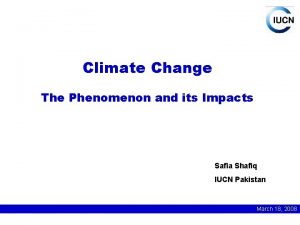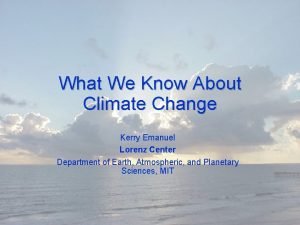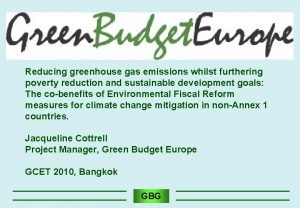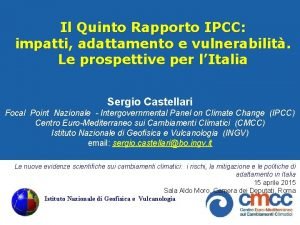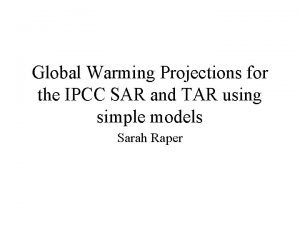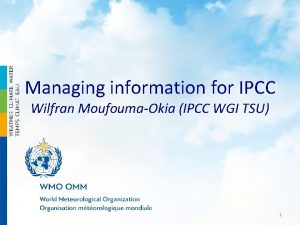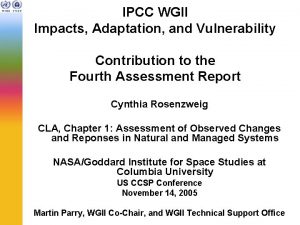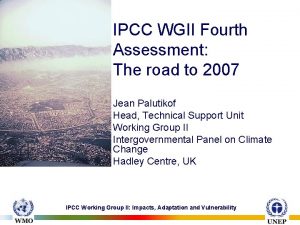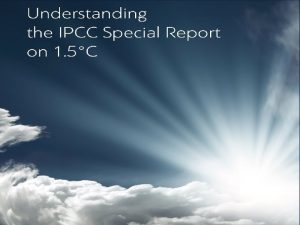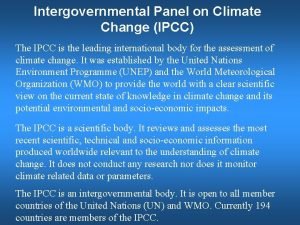Report on AR 4 of IPCC WGII and








- Slides: 8

Report on “AR 4 of IPCC: WGII and WGIII”

WGII – Impact, Adaptation and Vulnerability The Meeting resulted in the acceptance of WG II Contribution to the IPCC Fourth Assessment Report (AR 4) on Impact, Adaptation and Vulnerability of climate change n Major Findings: - Observational evidence from all continents and most oceans shows that many natural systems are being affected by regional climate changes, particularly temperature increases. - A global assessment of data since 1970 has shown it is likely that anthropogenic warming has had a discernible influence on many physical and biological systems. - More specific information is now available covering a wide range of systems and sectors not covered in previous assessments such as fresh water resources and their management; ecosystem; food, fibre and forest products; coastal systems and low-lying areas; industry, settlement and society; and health. n

WGII – Impact, Adaptation and Vulnerability - Magnitudes of impact can now be estimated more systematically for a range of possible increases in global average temperature. - Some large-scale climate events have the potential to cause very large impacts, especially after the 21 st century. - Adaptation will be necessary to address impacts resulting from the warming which is already unavoidable due to past emissions. - A wide array of adaptation options is available, but more extensive adaptation than is currently occurring is required to reduce vulnerability to future climate change. There are barriers, limits and costs, but these are not fully understood.

WGII – Impact, Adaptation and Vulnerability - Future vulnerability depends not only on climate change but also on development pathway. - Sustainable development can reduce vulnerability to climate change, and climate change could impede nations’ abilities to achieve sustainable development pathways. - Many impacts can be avoided, reduced or delayed by mitigation.

WGIII – Mitigation of Climate Change ( 1 of 3) n The Meeting resulted in the acceptance of WG III’s Contribution to the IPCC Fourth Assessment Report (AR 4) including approval of the Summary for Policy Makers and acceptance of the underlying report and technical summary. n Major Findings: - Greenhouse gas (GHG) emissions have increased 70% since 1970. With current policies GHG emission is projected to continue over the next few decades. - Changes in lifestyle and behaviour patterns can contribute to climate change mitigation across all sectors.

WGIII – Mitigation of Climate Change ( 2 of 3) The near-term health co-benefits from reduced air pollution as a result of actions to reduce GHG emissions can be substantial. - - There is substantial economic potential for the mitigation of global GHG emissions over the coming decades. The price of carbon could create incentives to reduce emissions. mic otential ndustrial in -mainly sector located is in the energy intensive industries. - Agricultural practices may make a significant contribution to increasing soil carbon sinks, to GHG emission reductions and by contributing biomass feed-stocks for energy use.

WGIII – Mitigation of Climate Change ( 3 of 3) - The waste sector can positively contribute to GHG mitigation at development. low cost and promote sustainable - There are multiple mitigation options in the transport sector: Improved vehicle efficiency measures; biofuels; modal shifts from road to rail and inland waterway shipping and from low occupancy to high-occupancy passenger transportation. - Energy efficiency for new and existing buildings e. g. low energy building.

Details Available n http: //www. ipcc. ch/SPM 13 apr 07. pdf n http: //www. ipcc. ch/SPM 040507. pdf
